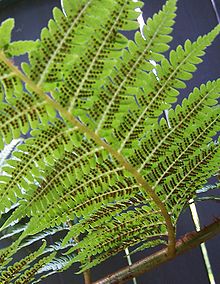Dicksoniaceae
| Dicksoniaceae | ||||||||||||
|---|---|---|---|---|---|---|---|---|---|---|---|---|

Tree ferns ( Dicksonia antarctica ) in Nunniong, Australia |
||||||||||||
| Systematics | ||||||||||||
|
||||||||||||
| Scientific name | ||||||||||||
| Dicksoniaceae | ||||||||||||
| ( C. Presl ) Bower |

Dicksoniaceae are a family of tree ferns (Cyatheales). All representatives also have a tree-shaped habit.
history
The tree ferns have been populating the earth since the Devonian , so for about 400 million years. At that time, bear moss plants (Lycopodiophyta) and horsetail (Sphenophyta) also emerged. In the Carboniferous they are among the dominant plant species and reached stem heights of up to 30 meters. Due to their great geological age, these plants are counted among the living fossils . With the advent of the seed plants, the tree ferns were displaced. Tree ferns were also tropical plants in the other geological epochs, there are also fossils of tree ferns in the geological layers of Central Europe , but in those times Europe had a tropical climate.
Occurrence
Tree ferns grow in tropical and subtropical areas of the world. Some species also tolerate the temperate climates of rainforests in Australia , Tasmania and New Zealand and neighboring areas ( Malaysia , Lord Howe Island ). In general, tree ferns do not tolerate prolonged drought, and only a few species (for example Dicksonia antarctica ) survive mild periods of frost.
New species are regularly discovered in studies in previously unexplored areas of New Guinea . At the same time, some species are endangered or extinct due to collection for the ornamental plant trade, intensive logging and loss of habitat .
description
The fronds of tree ferns are often more than 1 meter long in fully grown specimens, and almost always have one or more pinnatees. However, one species has simple, featherless fronds.
As with all ferns, reproduction takes place by means of spores, which are also formed in sporangia in tree ferns on the underside of the frond.
Unlike seed plants , tree ferns do not show any growth in the trunk. The trunk is supported by the root bundles that form as it grows.
Plants with a similar appearance are the cycads and palms . None of these groups of seed plants are related to the tree ferns (nor to any other ferns).
Economic importance
Tree ferns have been imported to England as ornamental plants since the 19th century, where they became popular plants in tropical houses. and In many other areas of the world with only low frosts, for example southern England with its maritime climate (influenced by the Gulf Stream ), allows planting in landscaped parks and gardens .
Ornamental plants of commercial importance are found in the Dicksoniaceae in the genus Dicksonia . Some Dicksonia species can also be cared for in very bright rooms that are cool in winter, or in winter gardens.
Systematics
The Dicksoniaceae family consists of three genera:
- Calochlaena maxon , with about five species.
- Dicksonia L'Hér. , with about 30 species.
-
Lophosoria C.Presl : With only 1–3 species in tropical America; including:
- Lophosoria quadripinnata (JFGmel.) C.Chr.
Other genera previously placed in this family now belong to other families within the tree ferns.
Individual evidence
- ^ Alan R. Smith, Kathleen M. Pryer, Eric Schuettpelz, Petra Korall, Harald Schneider, Paul G. Wolf: A classification for extant ferns. In: Taxon. Volume 55, No. 3, 2006, ISSN 0040-0262 , pp. 705–731, abstract, ( Memento of the original dated February 12, 2017 in the Internet Archive ) Info: The archive link was inserted automatically and has not yet been checked. Please check the original and archive link according to the instructions and then remove this notice. PDF file .

